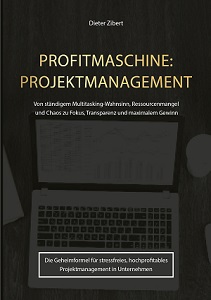Multitasking madness in project management
Are your projects stalling, falling behind schedule and blowing budgets, even though your teams are committed? Do your employees feel overworked while results fail to materialise? Then you are probably caught up in multitasking madness, an epidemic in project management that costs companies billions every year and undermines the productivity of your teams.
This article provides insight into the problem and introduces the proven TEMPO model, which will help you escape this dilemma and turn projects back into real success stories.
The multitasking madness – symptoms and causes
The multitasking madness is a systemic problem that manifests itself in a variety of symptoms. A typical example is the project employee who constantly jumps between tasks and projects, working on several at the same time and, despite their best efforts, never finishing anything. This situation is inefficient and demotivating.
If you understand how multitasking madness manifests itself in everyday life, you can take early countermeasures. Look out for the following typical signs:
- Longer project durations and lower project throughput: Constant context switching and cognitive overhead prolong projects and drastically reduce overall throughput.
- Lower quality of work results: Pressure leads to mistakes, overlooked details and costly rework.
- Increased error rates: Fragmented attention dramatically increases the risk of errors.
- Demotivated and overworked employees, even to the point of burnout: Despite high commitment, there is no real progress. This leads to stress, declining job satisfaction and burnout.
- Unreliable project plans and poor predictability: Overloaded resources render schedules obsolete and lead to crises of confidence.
- High costs due to inefficiency and wasted resources: Longer lead times, rework and demotivated employees significantly reduce profitability.
To effectively end the multitasking madness, it is worth taking a look at the underlying reasons. These causes are manifold and often deeply rooted in corporate culture, revealing systemic problems:
- The fallacy of ‘more is better’: The assumption that multitasking leads to higher productivity is wrong. Our brain only switches quickly between tasks (‘context switching’), which is inefficient.
- Unclear priorities and lack of focus: Without clear priorities, too many projects are started at the same time without taking capacity into account.
- Pressure from above and from customers: The pressure to start or complete projects quickly leads to too many initiatives being taken on, even when resources are insufficient.
- Lack of understanding of capacity limits: Organisations often underestimate their capacities and assume unrealistic 100% utilisation without buffer times.
- Lack of transparency about progress and utilisation: Without a clear view of project status and resource utilisation, it is impossible to make informed prioritisation decisions.
- Rewarding activity instead of results: ‘Being busy’ is often valued more than completing tasks, which reinforces harmful juggling.
The multitasking madness is therefore a deep-rooted systemic problem with serious negative effects. If you want to turn your projects into real ‘profit machines’, it is essential to recognise this madness, understand its causes and counteract it in a structured manner.
Ways out of the dilemma – the TEMPO model
To escape the multitasking madness, we need to consciously abandon the illusion that we can do everything at once and instead consistently focus on concentration and proactive capacity planning. The proven TEMPO model offers a tried-and-tested approach that you can use to realign your project management for the long term.
TEMPO is a concise german-language acronym that stands for five central and interdependent steps:
- Creating transparency (Transparenz schaffen)
- Identifying bottlenecks (Engpass identifizieren)
- Modelling of the bottleneck (Modellierung vom Engpass)
- Planning capacity around the bottleneck (Planung der Kapazitäten um den Engpass herum)
- Optimisation as a continuous process (Optimierung als kontinuierlicher Prozess)
Figure: TEMPO model with five consecutive steps for efficient and profitable project management
Let’s take a closer look at each step.
Creating transparency
The first and most fundamental step is to establish comprehensive, honest transparency about all ongoing projects, their status, the resources used and the available capacities. Without this clarity, you are flying blind.
What does creating transparency involve?
- Collect all projects and initiatives: Record all projects and ad hoc requests that tie up resources.
- Visualise progress and status: Use visual tools such as Kanban boards or project management software to clearly display project status.
- Record resource allocation: Document precisely who is working on which project and how the workload is distributed, taking into account line tasks and buffers.
- Identify early signs of bottlenecks: Clear visualisation helps to recognise overload and bottlenecks immediately.
- Create a common information base: All stakeholders must have access to this information to enable a common understanding of the situation.
Why is transparency so crucial?
Transparency reveals the truth about the multitasking madness: too many projects and overloaded resources. This is the wake-up call needed to reset priorities and lay the foundation for all TEMPO steps.
Identifying bottlenecks
Once you have created transparency, identify the primary bottleneck in your project flow. A bottleneck is the resource (person, team, department or process step) that limits the overall throughput of your system. These are often highly specialised experts.
How do you identify the bottleneck in your system?
- Follow the value stream of your projects: Where are tasks piling up? Where are projects waiting disproportionately long for a resource?
- Analyse utilisation and queues: Where is utilisation extremely high? Who is creating the bottleneck? Bottlenecks are indicated by high accumulations of work in progress (WIP).
- Ask your teams and employees directly: Your employees often know instinctively where the bottlenecks are.
- Look out for recurring waiting times and blockages: If projects repeatedly get stuck at the same point or with the same resource, this indicates a bottleneck.
The fundamental importance of bottlenecks:
The Theory of Constraints (TOC) teaches that the performance of a system is always determined by its bottleneck. Optimisation outside the bottleneck is pointless. Once you have identified the bottleneck, you know where the greatest leverage for improving your project performance lies and how to accelerate your ‘profit machine’.
Modelling the bottleneck
Once the bottleneck has been identified, the next step is to make it ‘modelable’: develop a clear, quantifiable understanding of its capacity, utilisation and mode of operation. The bottleneck should be viewed as an element that can be analysed and influenced.
How do you model the bottleneck and its characteristics?
- Define realistic capacity: Determine the maximum sustainable workload of the bottleneck per time period. Plan buffer times (e.g. 70–80% utilisation).
- Measure current utilisation: Record how much work is coming into the bottleneck and how much is being processed. Compare this with the capacity; the bottleneck is often chronically overloaded.
- Standardise the way you work at the bottleneck: Check whether processes can be standardised or tasks delegated to increase efficiency.
- Make dependencies and effects visible: Visualise which projects depend on the bottleneck and how long they take to complete.
- Create a clearly defined queue in front of the bottleneck: All new tasks for the bottleneck should be placed in a prioritised queue to avoid overload.
The overall goal of modelling:
The goal is to gain a precise, data-based understanding of the bottleneck. This enables realistic expectations and targeted planning to relieve the bottleneck or increase its capacity.
Planning capacity around the bottleneck
This is the core of the focus and paradigm shift. Align all your planning, prioritisation and resource allocation consistently with the capacity of the bottleneck. The motto is: the bottleneck determines the pace!
How do you plan effectively around the bottleneck?
- Radically limit parallel work by setting a clear upper limit for important tasks that can be worked on simultaneously (WIP limit) based on the bottleneck capacity. Projects for which there is currently no capacity available must wait in the queue. This is the only way to effectively end the illusion of multitasking.
- Prioritise projects consistently according to the bottleneck: Prioritise projects in the queue according to strategic value and urgency. The bottleneck always works on the most important project.
- Only feed the bottleneck when it is ready (‘pull principle’): Ensure that the bottleneck is continuously supplied with work, but only to the extent that it can process it. Avoid overload.
- Secure and protect the bottleneck: Protect bottleneck employees from unnecessary distractions and interruptions.
- Harmonise upstream and downstream processes: Ensure that there is no overproduction before the bottleneck and that work can be processed immediately after the bottleneck.
- Create conscious buffer times: Build buffer times into your planning, especially before bottlenecks and critical delivery dates, to absorb fluctuations.
The fundamental paradigm shift:
This planning requires a shift from the inefficient ‘push principle’ to the effective ‘pull principle’. This approach maximises overall throughput and promotes productivity at the bottleneck.
Optimisation as a continuous process
To work more efficiently in the long term and reliably deliver your projects, you need a clear roadmap and consistent action on the key levers.
How can you optimise continuously and sustainably?
To make your projects more efficient and profitable in the long term, you should embed these basic principles in your everyday work:
- Elevate the constraint: Increase the capacity of the current bottleneck through training, automation, process improvement or, as a last resort, additional resources.
- Find the next bottleneck: Once the original bottleneck has been alleviated, a new bottleneck will form. The TEMPO process then starts all over again.
- Regularly review and adjust WIP limits: Conduct regular reviews to assess progress, identify new bottlenecks and adjust WIP limits.
- Promote a culture of focus and completion: Encourage teams to focus on completing tasks. Reward the completion of projects, not just activity.
The overall goal of continuous optimisation:
The goal is to create a constant and predictable flow of completed projects that are delivered on time, on budget and with high quality. By making the bottleneck your primary focus, you transform your project management into an efficient and profitable ‘profit machine’.
Conclusion
Multitasking madness is a real, costly challenge that impairs the performance and profitability of many companies. It leads to long project times, lower quality, overworked teams and high pressure. The paradox: the more you try to do at once, the less you actually get done.
The key to escaping this madness lies in clearly abandoning the illusion of multitasking. Instead, create a culture in which focus and targeted work on bottlenecks are firmly anchored. The TEMPO model offers a clear, tried-and-tested and directly implementable roadmap for this. However, implementation requires courage and discipline: You have to learn to say ‘no’ to new projects when capacity is exhausted. Resistance is part of the process and a sign that you are on the right track. The rewards for this consistency are enormous: shorter lead times, fewer errors and better results, lower costs and faster value creation, highly motivated and committed teams, as well as more realistic plans and more reliable delivery dates.
When will you start using the TEMPO model?
Notes:
Dieter Zibert has described the TEMPO model in detail in his German-language book Profitmaschine Projektmanagement (Project Management Profit Machine). It is aimed at anyone who wants to not only manage their projects and, in particular, their multi-project management more efficiently, but also increase their profits in a targeted and measurable way.

Dieter Zibert
Dieter Zibert is an experienced project management expert, author and management consultant. With his many years of practical experience, he supports companies in planning and managing projects more efficiently and implementing them more profitably. In particular, he helps to implement professional project management efficiently and profitably in the context of functioning multi-project management.
In the t2informatik Blog, we publish articles for people in organisations. For these people, we develop and modernise software. Pragmatic. ✔️ Personal. ✔️ Professional. ✔️ Click here to find out more.

